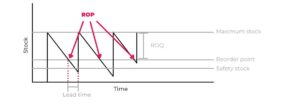Inventory management: How to order stock of your products


Almost every e-commerce business deals with how to work efficiently with inventory. Even more when the business is growing significantly, when approaching its sales peak of the year, Christmas or when plans to invest in a marketing campaign. How to estimate future demand? How to avoid out of stock? Or how to work with goods already in stock? These are common questions of online stores owners which you can find answers to in our article.
What is inventory forecasting
Inventory forecasting is an important part of inventory management. It is a process of calculating the quantity of products that will be needed for fulfilling future customer orders. The results are at the level of specific SKUs and for a limited period of time. The estimation takes into account historical sales, planned marketing activities and other external (un)predictable factors that may affect the final result (e.g. entry of significant competitors into the market, public holidays with unstable dates – Easter, global pandemics, legislative restrictions, etc.). Stock forecasting can be approached in a number of ways. In Skladon we recommend the following approach.
What you need to know for stock forecasting
1. Inventory turnover
As a first step, you need to set a period for which you are going to order products. You need to start with information how quickly your products will be selling. For tahe most accurate order you need to know the length of the production cycle of the SKUs you are purchasing and their turnover ratio. Inventory turnover shows how many times in a given period a particular product is sold and restocked.
The lower the inventory turnover, the higher the cost of goods acquisition and storage. However, a lower value is more appropriate for example for products that have a considerably longer production cycle or are unavailable from the manufacturer for a long time. Conversely, the higher the turnover rate you have, the better for your online store. You can sell your goods on time, your acquisition and storage costs are lower which is good also for your cash flow. Warning: too high turnover rate increases the risk of running out of stock! This risk is even higher with the longer lead times of your supplier(s).
The ideal turnover rate can vary significantly depending on the industry. The formula for calculating inventory turnover is:
Inventory turnover* = number of units sold / average number of units in stock
* for a certain period of time (e.g. 1 year)
For clarity, the formula for inventory turnover time is also used. The result tells you how many days it takes to sell out the goods and therefore need to order another identical amount of stock. The formula is as follows:
Inventory turnover time = 365 / inventory turnover
2. Sales trend
The second important indicator is tracking the sales trend. This is an analysis of changes in demand for your products over a period of time. For example, if you sell ski boots, the winter months will be the strongest for you. As an example, here is a chart of an e-shop with a highly seasonal brand.

When analysing the trend, we also recommend asking the following additional questions:
- Do the same customers buy the same items multiple times from you?
- Do the orders contain one or more items?
- Which products are often bought together?
- Which products are sold in particular months?
Anticipate the buying behaviour of your current and future customers. Track combinations of products on your online store where demand interacts with each other. For example, you will get to know which products should be included in promotional packages. Does the number of orders for these products change over time? Does the customer lifetime value increase? Look for these clues for optimal inventory planning.
3. Maximum limits for SKUs
Each warehouse has its own capacity limits in terms of space. For each SKU it is practical to determine the maximum quantity that can be stored at different times of the year. Of course, the larger the capacity of the warehouse is, the higher this number can be. However, you need to control the goods do not exceed the predicted storage space and that their storage is not unnecessarily costly.
4. Reorder point
When is the right time to reorder products from a manufacturer or supplier? Determine the Reorder Point (ROP) for each SKU to alert you to what SKUs are close to out of stock. A number of variables play a role in setting this point, such as:
- the length of lead time (i.e. the number of days from ordering the products from the manufacturer to placing the goods in your warehouse: production + transport + storage);
- average daily sales (the number of units of the product sold in the same period last year; ideally taking into account other external factors at the time – see above);
- safety stock (the number of units of a particular product that need to be kept in extra stock for unplanned cases;
- other variations (e.g. a sudden increase in demand for your product or new problems with your supplier).
5. Optimal reorder quantity
How many pieces of each SKU to order from the manufacturer or supplier? The answer to this question can be found under the term Reorder Quantity (ROQ). The quantity of products ordered should not be too high due to high acquisition and subsequent storage costs. It should not be too low as you risk out of stock of particular SKU before reordering (including safety stock – see above). Several factors influence the optimal Reorder Quantity, such as:
- average daily sales (30 days as standard);
- average lead time;
- reliability of the supplier / manufacturer.
The fewer days your inventory is in stock the higher the optimal reorder quantity and inventory turnover will be. For optimal inventory management, the reorder point (ROP) and reorder quantity (ROQ) work in tandem (see the figure below with constant variables for illustration). The moment you are reaching the reorder point, you start calculating the reorder quantity for the new order.

The benefits of proper inventory forecasting
Less inventory in stock, increased warehouse capacity, improved customer experience, reduced staff costs or more efficient collaboration with your supplier / manufacturer. These are the benefits that come from proper inventory forecasting. By constantly monitoring inventory turnover, stock levels and other trends you will be able to plan more accurately in both the short and long term. Ideally, the warehouse management system (WMS) automatically performs the analysis for you and also recommends further optimization steps.
How to store products that are not currently be selling? Read our another article “How to store goods for quick order picking“, specifically the chapter “ABC analysis“. If you have additional questions about the optimal inventory management or you wonder about the change of your logistics management, please do not hesitate to contact us.
